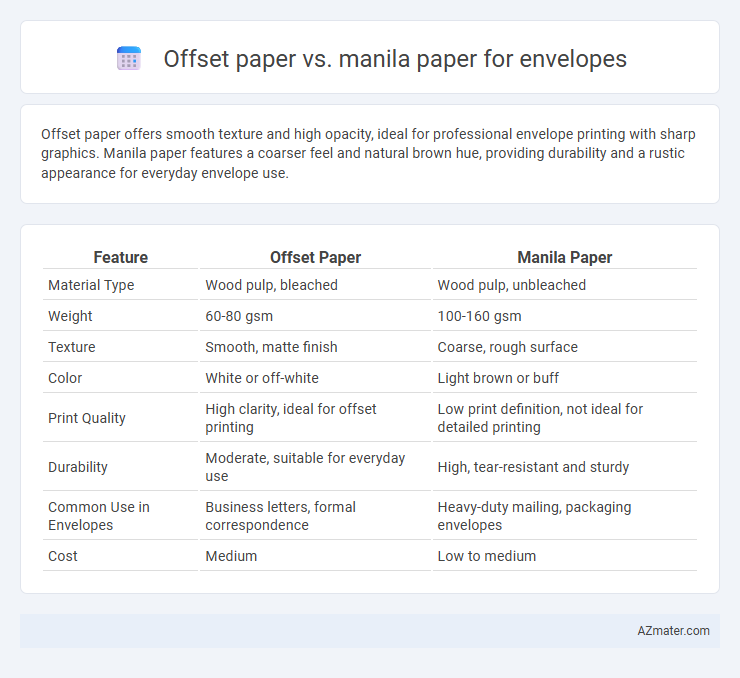Offset paper offers smooth texture and high opacity, ideal for professional envelope printing with sharp graphics. Manila paper features a coarser feel and natural brown hue, providing durability and a rustic appearance for everyday envelope use.
Table of Comparison
| Feature | Offset Paper | Manila Paper |
|---|---|---|
| Material Type | Wood pulp, bleached | Wood pulp, unbleached |
| Weight | 60-80 gsm | 100-160 gsm |
| Texture | Smooth, matte finish | Coarse, rough surface |
| Color | White or off-white | Light brown or buff |
| Print Quality | High clarity, ideal for offset printing | Low print definition, not ideal for detailed printing |
| Durability | Moderate, suitable for everyday use | High, tear-resistant and sturdy |
| Common Use in Envelopes | Business letters, formal correspondence | Heavy-duty mailing, packaging envelopes |
| Cost | Medium | Low to medium |
Introduction: Comparing Offset and Manila Paper for Envelopes
Offset paper offers a smooth, high-quality surface ideal for printing crisp text and vibrant images on envelopes, while Manila paper provides superior durability and a distinct texture suitable for heavy-duty mailing. Envelopes made from offset paper tend to have a professional finish favored in business correspondence, whereas manila paper envelopes are commonly used for documents requiring protection during transport. Selecting between offset and manila paper depends on the balance between aesthetic presentation and practical durability needed for the envelope's purpose.
What is Offset Paper?
Offset paper is a high-quality, uncoated sheet primarily used in printing processes like offset lithography, prized for its smooth finish, brightness, and excellent ink absorption. Compared to manila paper, which is thicker, coarser, and typically used for folders or envelopes requiring durability, offset paper offers superior print clarity and color vibrancy, making it an ideal choice for envelopes featuring detailed graphics or text. Its balanced weight and texture ensure efficient printing performance and professional appearance in various stationery applications.
What is Manila Paper?
Manila paper is a durable, coarse-textured kraft paper traditionally used for folders and envelopes due to its strength and flexibility. Unlike offset paper, which is smooth and designed for high-quality printing, manila paper offers excellent tear resistance and is ideal for packaging or mailing applications. Its natural brown color and robust fibers make it a cost-effective choice for creating sturdy envelopes capable of withstanding handling and transport.
Material Composition and Texture Differences
Offset paper, made primarily from wood pulp with minimal fillers, features a smooth, matte finish ideal for high-quality printing in envelopes. Manila paper consists of pulped abaca fibers, offering a coarser texture and greater durability, making it suitable for sturdy, reusable envelopes. The material composition differences result in offset paper being thinner and smoother, while manila paper is thicker with a rougher surface that enhances tear resistance.
Durability and Strength: Offset vs Manila
Offset paper offers moderate durability with a smooth finish ideal for printing but tends to be less resistant to tearing compared to Manila paper. Manila paper, known for its fibrous composition, provides superior strength and durability, making it more suitable for heavy-duty envelopes that require protection during handling and shipping. The inherent toughness of Manila ensures that envelopes maintain integrity under stress, unlike offset paper which is better suited for lightweight, everyday correspondence.
Printability and Surface Quality
Offset paper offers superior printability with excellent ink absorption and sharp image reproduction, making it ideal for high-quality envelope printing. Manila paper, characterized by its rougher surface and lower brightness, results in less precise prints and may cause ink smudging or uneven coverage. Surface quality of offset paper is smoother and more consistent, enhancing print clarity, whereas manila paper's coarse texture limits detailed printing applications.
Color Options and Visual Appeal
Offset paper offers a wide range of vibrant color options and a smooth, matte finish that enhances the visual appeal of envelopes with sharp, crisp print quality. Manila paper typically features a natural, earthy tone with limited color choices, providing a rustic, vintage look that appeals to eco-friendly or traditional aesthetics. The choice between offset and manila paper depends on whether bold colors and modern design or muted tones and classic texture best suit your envelope presentation.
Cost Comparison: Offset Paper vs Manila Paper
Offset paper is generally more affordable than Manila paper due to its widespread availability and lower manufacturing costs. Manila paper tends to be pricier because of its thicker texture and durability, making it ideal for premium envelopes. For budget-sensitive projects, offset paper offers cost-efficiency, while Manila paper provides added value with enhanced strength and aesthetic appeal.
Environmental Impact and Sustainability
Offset paper for envelopes, typically made from wood pulp with minimal coatings, offers higher recyclability and biodegradability compared to Manila paper, which is usually composed of abaca fibers and often treated with chemicals that can hinder composting processes. The production of offset paper generally consumes less water and energy with lower carbon emissions, contributing to a smaller overall environmental footprint. Manila paper, while durable, involves more resource-intensive processing and limited recyclability, making offset paper the more sustainable choice for eco-conscious envelope manufacturing.
Choosing the Right Paper for Your Envelope Needs
Offset paper offers a smooth surface and excellent print quality, ideal for professional-looking envelopes requiring crisp text and vibrant colors, while Manila paper provides a more durable, textured finish suitable for heavy-duty, everyday use and mailing. Selecting the right paper depends on the envelope's purpose: offset paper enhances formal invitations and branded correspondence, whereas Manila paper fits better for sturdier, bulkier contents like documents or samples. Weight and finish are key factors--offset paper typically ranges from 60 to 80 gsm, ensuring lightweight elegance, whereas manila paper is thicker, around 90 to 120 gsm, offering robustness and tear resistance.

Infographic: Offset paper vs Manila paper for Envelope
 azmater.com
azmater.com